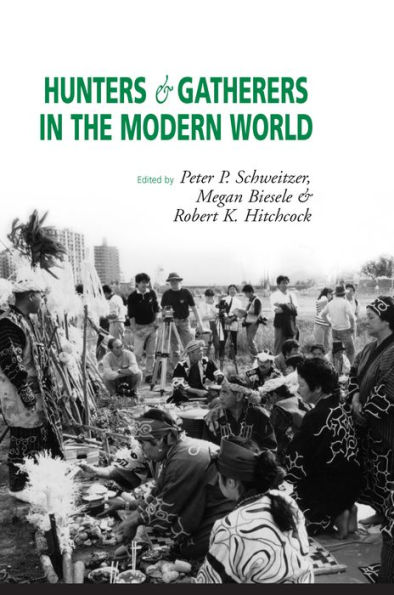Hunters and Gatherers in the Modern World: Conflict, Resistance, and Self-Determination / Edition 1 available in Hardcover, Paperback

Hunters and Gatherers in the Modern World: Conflict, Resistance, and Self-Determination / Edition 1
- ISBN-10:
- 1571811028
- ISBN-13:
- 9781571811028
- Pub. Date:
- 10/01/2002
- Publisher:
- Berghahn Books, Incorporated
- ISBN-10:
- 1571811028
- ISBN-13:
- 9781571811028
- Pub. Date:
- 10/01/2002
- Publisher:
- Berghahn Books, Incorporated

Hunters and Gatherers in the Modern World: Conflict, Resistance, and Self-Determination / Edition 1
Buy New
$39.95Buy Used
$27.19-
-
SHIP THIS ITEM
Temporarily Out of Stock Online
Please check back later for updated availability.
-
Overview

Product Details
| ISBN-13: | 9781571811028 |
|---|---|
| Publisher: | Berghahn Books, Incorporated |
| Publication date: | 10/01/2002 |
| Edition description: | New Edition |
| Pages: | 512 |
| Product dimensions: | 5.50(w) x 8.50(h) x 1.03(d) |
About the Author
Robert K. Hitchcock is an Adjunct Professor of Anthropology in the Department of Anthropology at the University of New Mexico in Albuquerque, New Mexico. Previously he was Professor of Anthropology and Geography and Coordinator of African Studies at the University of Nebraska-Lincoln (1983-2006). He has worked with San communities in Botswana, Namibia, Zimbabwe, and Zambia since 1975, and he serves on the board of the Kalahari Peoples Fund. He worked for the government of Botswana in the Ministry of Local Government and Lands (1977-79) and Ministry of Agriculture (1980-1982) and has served as a consultant to the Department of Wildlife and National Parks in Botswana. He has also worked for the governments of Somalia, Swaziland, and Lesotho, as well as for the United Nations High Commissioner for Refugees and the World Bank. His publications include Kalahari Cattle Posts (Government of Botswana, 1978); Endangered Peoples of Africa and the Middle East: Struggles to Survive and Thrive (co-editor, Greenwood, 2002); Indigenous Peoples' Rights in Southern Africa (co-editor, International Work Group for Indigenous Affairs, 2004).
Table of Contents
List of Illustrations PrefaceIntroduction Robert K. Hitchcock and Megan Biesele
Chapter 1. Silence and Other Misunderstandings: Russian Anthropology, Western Hunter-Gatherer Debates, and Siberian Peoples Peter P. Schweitzer
PART I: WARFARE AND CONFLICT RESOLUTION
Chapter 2. Visions of Conflict, Conflicts of Vision among Contemporary Dene Tha Jean-Guy A. Goulet
Chapter 3. Warfare among the Hunters and Fishermen of Western Siberia Liudmila A. Chindina
Chapter 4. Homicide and Aggression among the Agta of Eastern Luzon, the Philippines, 1910–1985 Marcus B. Griffin
Chapter 5. Conflict Management in a Modern Inuit Community Jean L. Briggs
Chapter 6. Wars and Chiefs among the Samoyeds and Ugrians of Western Siberia Andrei V. Golovnev
Chapter 7. Ritual Violence among the Peoples of Northeastern Siberia Elena P. Batianova
Chapter 8. Patterns of War and Peace among Complex Hunter-Gatherers: The Case of the Northwest Coast of North America Leland Donald
PART II: RESISTANCE, IDENTITY AND THE STATE
Chapter 9. The Concept of an International Ethnoecological Refuge Olga Murashko
Chapter 10. Aboriginal Responses to Mining in Australia: Economic Aspirations, Cultural Revival, and the Politics of Indigenous Protest David S. Trigger
Chapter 11. Political Movement, Legal Reformation, and Transformation of Ainu Identity Takashi Irimoto
Chapter 12. Tracking the “Wild Tungus” in Taimyr: Identity, Ecology, and Mobile Economies in Arctic Siberia David G. Anderson
Chapter 13. Marginality with a Difference, or How the Huaorani Preserve Their Sharing Relations and Naturalize Outside Powers Laura Rival
PART III: ECOLOGY, DEMOGRAPHY, AND MARKET ISSUES
Chapter 14. “Interest in the Present” in the Nationwide Monetary Economy: The Case of Mbuti Hunters in Zaire Mitsuo Ichikawa
Chapter 15. Dynamics of Adaptation to Market Economy among the Ayoréode of Northwest Paraguay Volker von Bremen
Chapter 16. Can Hunter-Gatherers Live in Tropical Rain Forests? The Pleistocene Island Melanesian Evidence Matthew Spriggs
Chapter 17. The Ju/’hoansi San under Two States: Impacts of the South West African Administration and the Government of the Republic of Namibia Megan Biesele and Robert K. Hitchcock
Chapter 18. Russia’s Northern Indigenous Peoples: Are They Dying Out? Dmitrii D. Bogoiavlenskii
PART IV: GENDER AND REPRESENTATION
Chapter 19. Gender Role Transformation among Australian Aborigines Robert Tonkinson
Chapter 20. Names That Escape the State: Hai//om Naming Practicesc versus Domination and Isolation Thomas Widlok
Chapter 21. Central African Government’s and International NGOs’ Perceptions of Baka Pygmy Development Barry S. Hewlett
Chapter 22. The Role of Women in Mansi Society Elena G. Fedorova
Chapter 23. Peacemaking Ideology in a Headhunting Society: Hudhud, Women’s Epic of the Ifugao Maria V. Staniukovich
PART V: WORLD-VIEW AND RELIGIOUS DETERMINATION
Chapter 24. Painting as Politics: Exposing Historical Processes in Hunter-Gatherer Rock Art Thomas A. Dowson
Chapter 25. Gifts from the Immortal Ancestors: Cosmology and Ideology of Jahai Sharing Cornelia M. I. van der Sluys
Chapter 26. Time in the Traditional World-View of the Kets: Materials on the Bear Cult Evgeniia A. Alekseenko
Chapter 27. Lexicon as a Source for Understanding Sel’kup Knowledge of Religion Alexandra A. Kim
Notes on Contributors
Appendix: A Note on the Spelling of Siberian Ethnonyms
Index
